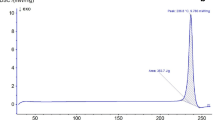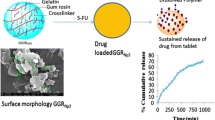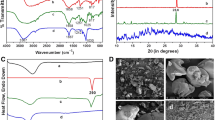Abstract
In the present work, guar gum microspheres containing methotrexate (MTX) were prepared and characterized for local release of drug in the colon, which is a prerequisite for the effective treatment of colorectal cancer. Guar gum microspheres were prepared by the emulsification method using glutaraldehyde as a cross-linking agent. Surface morphological characteristics were investigated using scanning electron microscopy. Particle size, shape, and surface morphology were significantly affected by guar gum concentration, glutaral dehyde concentration, emulsifier concentration (Span 80), stirring rate, stirring time, and operating temperature. MTX-loaded microspheres demonstrated high entrapment efficiency (75.7%). The in vitro drug release was investigated using a US Pharmacopeia paddle type (type II) dissolution rate test apparatus in different media (phosphate-buffered saline [PBS], gastrointestinal fluid of different pH, and rat cecal content release medium), which was found to be affected by a change to the guar gum concentration and glutaraldehyde concentration. The drug release in PBS (pH 7.4) and simulated gastric fluids followed a similar pattern and had a similar release rate, while a significant increase in percent cumulative drug release (91.0%) was observed in the medium containing rat cecal content. In in vivo studies, guar gum microspheres delivered most of their drug load (79.0%) to the colon, whereas plain drug suspensions could deliver only 23% of their total dose to the target site. Guar gum microspheres showed adequate potential in achieving local release of drug in in vitro release studies, and this finding was further endorsed with in vivo studies.
Similar content being viewed by others
References
Giovannucci E. Epidemiologic studies of folate and colorectal neoplasia: a review.J Nutr. 2002;132:2350S-2355S.
Giovannucci E. Alcohol, one-carbon metabolism, and colorectal cancer: recent insights from molecular studies.J Nutr. 2004;134: 2475S-2481S.
Sidransky D, Tokino T, Hamilton SR, Kinzler KW, Levin B, Frost P. Identification of ras oncogene mutations in the stool of patients with curable colorectal tumors.Science. 1992;256:102–105.
Traverso G Jr, Shuber A Jr, Levin B Jr, Johnson C Jr, Olsson L Jr, Schoetz DJ Jr. Detection of APC mutations in fecal DNA from patients with colorectal tumors.N Engl J Med. 2002;346:311–320.
Calabresi P, Chabner BA. Chemotherapy of neoplastic diseases. In: Hardman JG, Limbird LE, Perry BM, Raymond WR, eds.Goodman and Gilman’s The Pharmacological Basis of Therapeutics. New Delhi, India: McGraw-Hill; 1996:1381–1388.
Michor F, Iwasa Y, Lengauer C, Nowak NA. Dynamics of colorectal cancer.Semin Cancer Biol. 2005;15:484–493.
Krishnaiah YSR, Satyanarayan S. Colon-specific drug delivery systems. In: Jain NK, ed.Advances in Controlled and Novel Drug Delivery. New Delhi, India: CBS Publishers and Distributors; 2001:89–119.
Ciftci K, Groves MJ. Delivery of antitumor compounds to the rat colon: in vitro and in vivo evaluation.Int J Pharm. 1996;145:157–164.
Levine DS, Raisys VA, Aindardi V. Coating of oral beclomethasone dipropionate capsules with cellulose acetate phthalate enhances delivery of topically active anti-inflammatory drug to the terminal ileum.Gastroenterology. 1987;92:1037–1044.
Rasmussen SN, Bondesen S, Hvidberg EF, et al. 5-Aminosalicylic acid in a slow-release preparation: bioavailability, plasma level, and excretion in humans.Gastroenterology. 1982;83:1062–1070.
Lamprecht A, Yamamoto H, Takeuchi H, Kawashima Y. Observations in simultaneous microencapsulation of 5-fluorouracil and leucovorin for combined pH-dependent release.Eur J Pharm Biopharm. 2005;59:367–371.
Rodriguez M, Vila-Jato JL, Torres D. Design of a new multiparticulate system for potential site-specific and controlled drug delivery to the colonic region.J Control Release. 1998;55:67–77.
Chourasia MK, Jain SK. Design and development of multiparticulate system for targeted drug delivery to colon.Drug Deliv. 2004;11:201–207.
Klotz U. Clinical pharmacokinetics of sulphasalazine, its metabolites and other products of 5-aminosalicylic acid.Clin Pharmacokinet. 1985;10:285–302.
Chourasia MK, Jain SK. Polysaccharides for colon targeted drug delivery.Drug Deliv. 2004;11:129–148.
Sinha VR, Kumria R. Novel oral colon-specific drug delivery systems for pharmacotherapy of peptide and nonpeptide drugs.Drugs Today (Barc). 1999;35:537–580.
Goldstein AM, Alter EN, Seaman JK. Guar gum. In: Whistler RL, ed.Industrial gums, polysaccharides and their derivatives. New York, NY: Academic Press; 1993:303–321.
Ramaprasad YV, Krishaniah YSR, Satyanarayana S. Trends in colonic drug delivery: a review.Indian Drugs. 1995;33:1–10.
Chourasia MK, Jain SK. Potential of guar gum microspheres for target specific drug release to colon.J Drug Target. 2004;12: 435–442.
Wong TW, Chan LW, Lee HY, Heng PW. Release characteristics of pectin microspheres prepared by an emulsification technique.J Microencapsul. 2002;19:511–522.
Alkaysi HN, Gharaibeh AM, Salem MA. High-performance liquid chromatographic determination of methotrexate in plasma.Ther Drug Monit. 1990;12:191–194.
Van den Mooter G, Kinget R. Oral colon-specific drug delivery: a review.Drug Deliv. 1995;2:81–93.
Krishnaiah YSR, Satyanarayana V, Dinesh Kumar B, Karthikeyan RS. in vitro drug release studies on guar gum-based colon targeted oral drug delivery systems of 5-fluorouracil.Eur J Pharm Sci. 2002;16: 185–192.
Deasy PB.Microencapsulation and Related Drug Processes. New York, NY: Marcel Dekker; 1984.
Sinha VR, Mittal BR, Bhutani KK, Kumria R. Colonic drug delivery of 5-fluorouracil: an in vitro evaluation.Int J Pharm. 2004;269:101–108.
Author information
Authors and Affiliations
Corresponding author
Additional information
Published: September 8, 2006
Rights and permissions
About this article
Cite this article
Chaurasia, M., Chourasia, M.K., Jain, N.K. et al. Cross-linked guar gum microspheres: A viable approach for improved delivery of anticancer drugs for the treatment of colorectal cancer. AAPS PharmSciTech 7, 74 (2006). https://doi.org/10.1208/pt070374
Received:
Accepted:
Published:
DOI: https://doi.org/10.1208/pt070374




